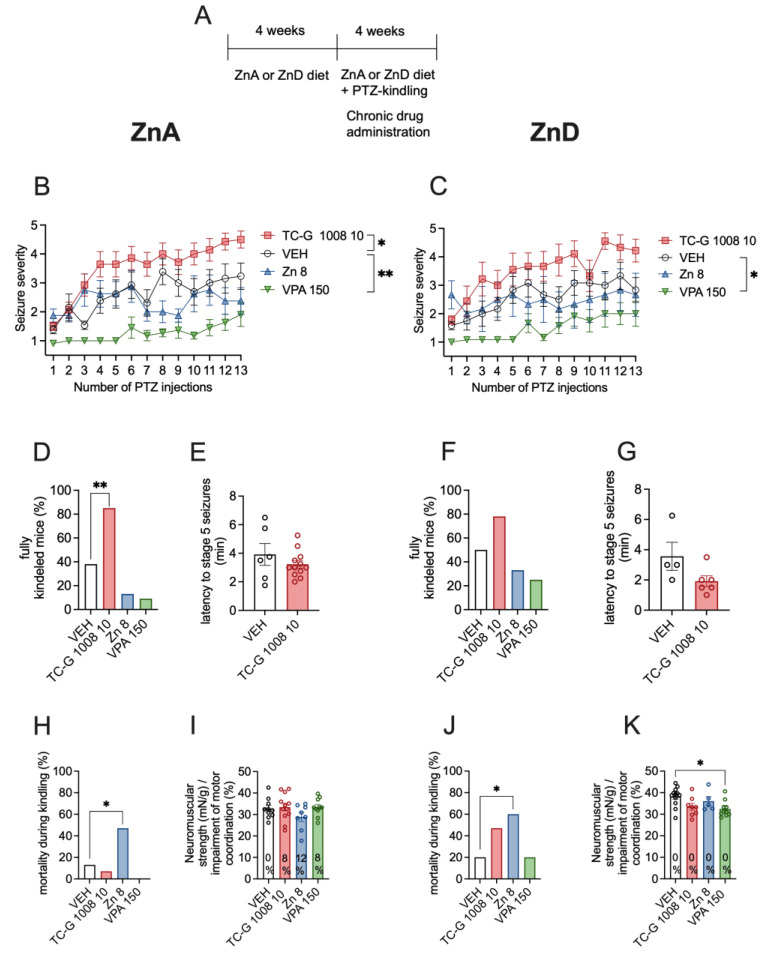Figure 4.
Chronic effects of TC-G 1008 (10 mg/kg), ZnCl2 (8 mg Zn/kg), or VPA (150 mg/kg) on pentylenetetrazole (PTZ)-induced epileptogenesis in mice fed the ZnA or ZnD diet. (A) Experimental paradigm. Mice were fed the ZnA or ZnD diet for 4 weeks. Following a 4-week dietary zinc restriction, PTZ-kindling model of epilepsy began. TC-G 1008 (10 mg/kg), ZnCl2 (8 mg Zn/kg), VPA (150 mg/kg), or VEH were injected i.p. once daily on every alternate day during weekdays. 30 min later, PTZ (40 mg/kg) was injected i.p. Immediately after each PTZ injection the mice were subjected to an evaluation of behavioral seizures, which lasted 30 min. The total number of PTZ injections was 13. The ZnA or ZnD diet was continued during this chronic paradigm. (B,C) Data are expressed as means ± SEM of seizure severity after each PTZ injection. They were analyzed by two-way repeated measures ANOVA and a Dunnett’s multiple comparison test. (D,F) The percentage of mice displaying consecutive stage 5 seizures (fully kindled mice) after the last PTZ injection. Data were analyzed by the Chi square test. (E,G) Data are expressed as means ± SEM of latency to stage 5 seizures after the last PTZ injection. They were analyzed by the Student’s t-test. (H, J) Mortality during kindling was analyzed by the Chi square test after the last PTZ injection. (I,K) Neuromuscular strength (assessed in the grip strength test) and motor coordination (assessed in the chimney test, expressed as % of mice that displayed motor impairment in this test) after the last PTZ injection. Neuromuscular strength was analyzed by one-way ANOVA and a Dunnett’s multiple comparison test. Motor coordination was analyzed by Chi square test. n at the end of kindling procedure: n = 13 ZnA VEH, n = 14 ZnA TC-G 1008 10 mg/kg, n = 8 ZnA Zn 8 mg/kg, n = 11 ZnA VPA 150 mg/kg, n = 12 ZnD VEH, n = 9 ZnD TC-G 1008 10 mg/kg, n = 6 ZnD Zn 8 mg/kg, n = 12 ZnD VPA 150 mg/kg. Unequal group sizes result from mortality during kindling. Statistical details: (B) drug (F(3,42) = 15.24, p < 0.0001), time (F(8.013, 336.5) = 10.33, p < 0.0001), drug × time (F(36,504) = 1.870, p = 0.002) (two-way repeated measures ANOVA); (C) drug (F(3,35) = 8.557, p = 0.0002), time (F(6.220, 217.7) = 5.922, p < 0.0001), drug × time (F(36,420) = 0.9082, p = 0.6244) (two-way repeated measures ANOVA), (D) p = 0.01 (TC-G 1008), p = 0.2 (ZnCl2), p = 0.09 (VPA) (Chi square test), (E) t(16) = 1.056, p = 0.3068 (Student’s t-test), (F) p = 0.19 (TC-G 1008), p = 0.5 (ZnCl2), p = 0.21 (VPA) (Chi square test), (G) t(8) = 1.927, p = 0.0901 (Student’s t-test), (H) p = 0.37 (TC-G 1008), p = 0.05 (ZnCl2), p = 0.21 (VPA) (Chi square test), (I) neuromuscular strength: F(3,36) = 1.428, p = 0.25 (one-way ANOVA), motor coordination: p = 0.35 (TC-G 1008), p = 0.25 (ZnCl2), p = 0.31 (VPA) (Chi square test), (J) p = 0.12 (TC-G 1008), p = 0.03 (ZnCl2), p = 1 (VPA) (Chi square test), (K) neuromuscular strength: F(3,31) = 3.799, p = 0.02 (one-way ANOVA). * p < 0.05, ** p < 0.01 vs. VEH group (Dunnett’s multiple comparison test or the Chi square test).

